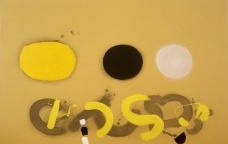
newspaper
agenda cultural
For the first time, the Peggy Guggenheim Collection celebrates a great American painter, Adolph Gottlieb, with a retrospective exhibition. Following exhibitions dedicated to William Baziotes and Richard Pousette-Dart, the Peggy Guggenheim Collection turns to another of the group of the American Abstract Expressionists, a movement closely tied to Peggy Guggenheim’s career as collector and gallery owner. Gottlieb’s paintings were exhibited in the 1945 Autumn Salon exhibition at her Art of This Century gallery, along with other Abstract Expressionists such as Robert Motherwell, Mark Rothko, Clyfford Still, Willem de Kooning, and Jackson Pollock.
The story of Adolph Gottlieb (1903–1974) is typical of that of the group of Abstract Expressionists. Close friends with Milton Avery and Mark Rothko from the early 1930s, he was a cofounder of The Ten, a loosely defined group of Expressionist painters that befan in 1935. He worked for the Federal Art Project of the New Deal in the late 30s. Studiously attentive to the European avant-garde, Cubism and Surrealism in particular, he developed a pictorial format in the 1940s that he termed the pictograph, a grid into which he inserted a personal symbolic language of forms, evocative of primitive myth. In 1950 Gottlieb was the organizer of The Irascibles, a group that formed in protest to its exclusion from the Metropolitan Museum of Art and which has been immortalized in a photograph by Nina Leen.
In the 1950s Gottlieb’s work became more abstract, gestural, and expressionist, leading up to a series of images, or Bursts, for which he is now best known. Nevertheless, these formed only one episode in a richly varied artistic progression that this exhibition—with over sixty paintings, many works on paper, and six sculptures—sets out to illustrate.
Adolph Gottlieb: A Retrospective has been organized in partnership with the Adolph and Esther Gottlieb Foundation, New York. It includes loans from the American Contemporary Art Gallery, Munich, various private collections, as well as the Solomon R. Guggenheim Museum, the Musée National d’Art Moderne Centre Pompidou, and the Museum Frieder Burda.

Adolph Gottlieb, Three Discs on Chrome Ground, 1969. Oil and acrylic on canvas, 121 x 183 cm. Collection of the Adolph and Esther Gottlieb Foundation, New York / Courtesy of Galeria Elvíra González, Madrid

